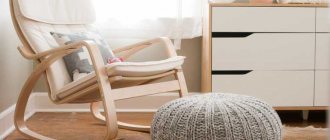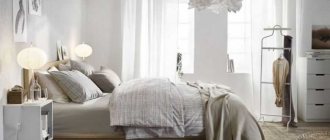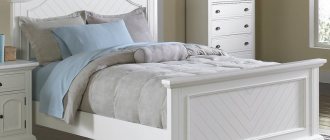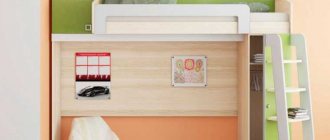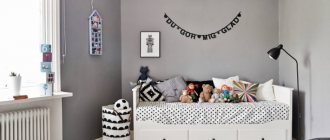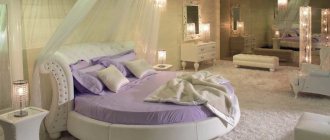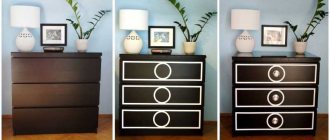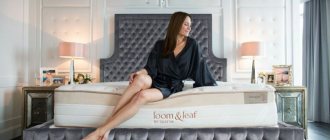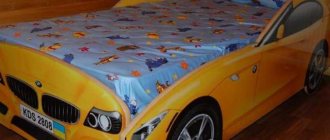Today's furniture market offers a wide selection of different options for bedroom equipment, and although many of them are distinguished by increased comfort and beauty, they are not available to everyone. And it’s not always about their price: not every apartment has the space necessary to accommodate them.
Sleeping on a bunk bed or loft bed is always more interesting - and not only that.
Many families still live in rather cramped conditions, which dictates the conditions for choosing furniture. And in this case, preference is given to bunk beds, which are in great demand.
The IKEA chain of stores offers products for all tastes and financial capabilities.
Advantages and disadvantages of the IKEA bunk bed
Speaking about the advantages of IKEA beds, the following are noted:
- High quality of the material from which they are made;
- Strength and reliability of structures;
- The widest range of colors;
- Variety of models;
- Possibility of use by children and adults;
- Compact and multifunctional;
- Wide price range;
- A variety of design solutions allows you to fit the design into any interior.
Among the main advantages of IKEA bunk beds, they note their ability to save room space and avoid unnecessary expenses on purchasing additional furniture.
How to choose the right material
IKEA offers a wide selection of products made from various materials, the most popular of which are:
- Tree
- Metal
- Plastic.
Solid wood is a high-quality natural “warm” environmentally friendly raw material.
Among the most popular types of wood for making bunk beds are:
- Oak, from which products with an unlimited service life are made; they are beautiful, durable and reliable, fit perfectly into any interior, but are quite expensive;
- High-quality and beautiful structures are made from solid birch, but they are also not cheap;
- Beech, ash, alder wood has magnificent shades and will decorate any product; their cost is lower than oak and birch;
- Solid pine is the most common material for making bunk beds, it is of high quality and the cheapest.
When choosing pine products, you need to pay attention to ensuring that there are as few traces of knots as possible on it, otherwise it will soon begin to collapse.
The metal base is strong and durable, while it gives the product a certain lightness and delicacy. At the same time, when choosing products whose frame is made of metal, it is necessary to pay attention to the quality of processing of the metal elements.
They should not have cracks, burrs, or chips.
Plastic is commonly used to make bunk beds for little ones. They are presented in a wide range of colors and a variety of models.
The design of such beds is often associated with fairy-tale images.
Material of manufacture
The Swedish store uses the same materials as in conventional furniture production. Basically, they are divided into 3 categories:
- Wooden beds for children with sides. Basically, regular solid pine is used so as not to increase the cost of production. The most beautiful and comfortable ones have practically no design flaws. Suitable for any child, regardless of gender.
By the way, the wood that is on sale is not of the highest class. It will have noticeable stains from knots, but it will be perfectly polished, without cracks.
- IKEA also sells metal bunk beds. They are much stronger, more brutal, but well suited for a children's room. They can be purchased for very active children if there are concerns for their safety. Such cribs are well suited even for older children, as they can easily withstand more than 200 kilograms.
- The Ikea catalog also includes loft beds that are made from chipboard. Their difference is that the lower tier is used as a work desk and there is room in the crib for only one child. There is also a nice bunk bed with a sofa underneath. It combines an area for entertainment and sleep.
What to especially pay attention to when choosing
Purchasing furniture in a store is always a serious and responsible matter, so you need to choose it slowly, paying attention to the design features. It is worth considering that IKEA offers only high quality products from trusted manufacturers.
However, this does not eliminate the need to carefully check the selected model.
- It is necessary to examine the bottom of the upper berth: it should be made of durable solid wood slats and provide good support for the body.
For an adult, it is determined by weight; for a child, it is determined by the desire to jump on the bed. - Among the dangerous elements, the quality of which requires serious inspection, there may be a staircase to the second floor if it:
- Made from low-quality material;
- Inconveniently located;
- Manufactured with violations of technology;
- It has burrs, cracks, and chips, which increases the possibility of injury during use.
As a rule, IKEA in Moscow and other cities pays the most serious attention to the quality of the staircase, which practically eliminates problems with its use.
- The quality of the material is important, especially the degree of its “maturity”.
After drying, the raw material “warps”, the bed begins to creak, and its deformation is possible. When choosing products made from solid pine, you need to check the surface: on a quality product there should be no traces of knots, or their number should be minimal. Otherwise, despite the fact that a product with traces of knots looks quite impressive, it will soon become unusable. - Functionality: the presence of a full-fledged sleeping place and desk, drawers, wardrobe, sofa in the set will determine the use of the product: only for sleeping or for sleeping, working and relaxing.
- It is imperative to check the presence and strength of the sides on the second tier, as well as the strength and stability of the ladder to the top.
If a bed is purchased for adults, it is better if the staircase is located at a certain angle, without creating inconvenience when climbing to the second floor and descending, which will eliminate the possibility of the structure tipping over.
Material from which the furniture is made
Wood is a safe, environmentally friendly and durable material and has good thermal conductivity. It does not heat up, but retains heat, and it is more pleasant for the baby to touch the warm wooden side than the cold metal.
Each type of wood has its own characteristics:
- Pine is a “budget” option, but is inferior in strength to oak and beech. There should be no knots on the solid pine, otherwise the bed will soon become unusable.
- Birch looks beautiful and is a high-quality material, but it is not cheap.
- Beech, ash and alder offer a striking variety of shades. Such furniture will decorate any interior.
- Oak is the most durable, but also the most expensive option.
IMPORTANT! When choosing a bed made of wood, you need to pay attention to how and with what its surface is treated.
For example, the IKEA Nordal bunk bed, made of solid pine, is stained and coated with hypoallergenic varnish. The color cannot be changed, but the coating is smooth, pleasant to the touch, without unevenness.
But the “Midal” model was not initially treated with any means, so the surface is uneven, rough and there is a risk of injury. You will have to first work with a file, and then cover it yourself with paint or varnish. Not every person can do this work, but after doing it, you will be sure of good polishing, and “Midal” costs less.
Metal. The metal pipe frame is strong and durable. It is not affected by fungi, mold, or microorganisms. The fire resistance of metal is especially important for a children's room, as well as wear resistance (it is difficult to damage, bend or break).
The design of metal beds is more modest compared to wooden ones, but this “minus” is easily compensated by the apparent lightness and delicacy of metal structures, which is important for small rooms.
The disadvantage of metal bunk beds is that they do not retain heat and will always feel unpleasantly cold when touched.
All metals, except aluminum, are susceptible to corrosion, so before purchasing you need to find out whether the parts have a protective polymer coating applied to them. For example, a bunk bed from IKEA “Svarta”, consisting of hollow steel pipes, is coated with anti-corrosion varnish based on epoxy resin.
Plastic. Modern technologies make it possible to create durable plastic furniture. Most often, pull-out beds for babies are made from plastic, which have the most amazing shapes, for example, in the form of a car or an animal.
Dimensions
When choosing a two-tier structure, you definitely need to pay attention to its dimensions. If it is purchased for an adult or teenager, then its parameters must be at least 90x200 cm. It is worth considering that for a child who is still growing, it must be purchased taking into account an additional length of at least twenty centimeters.
If a bed is chosen for children, it is important to pay attention to the height of the product.
Taking into account the fact that not every room has high ceilings, and children, as you know, love to jump on the bed, the sleeping area may end up right under the ceiling, which can lead to head and spinal injuries. Therefore, when purchasing a product for a child, preference should be given to beds with a height of 160 to 180 cm.
It is important to note that the design in the nursery should not be bulky and “fall out” from the overall interior of the room.
My two-room apartment
After the publication of the article about our IKEA TROMSO bunk loft bed, you, the readers, received many questions both in the comments and in the feedback form, with a request to send a drawing or detailed photos of the staircase overlay.
Children are children, and the thirst for knowledge, including through bumps and bruises, leads both my youngest and, apparently, your children to this ladder. And so that my child at such a young age would not climb and fall from the attic bed, or rather from its ladder, I made a protective pad.
I will try to explain its principle in more detail and give you sketches with photos.
So, firstly, the material. I used a composite material consisting of three layers: the inside is plastic, the outside is coated on both sides with aluminum. I got it from some “advertisers” I knew, asking for scraps of the size I needed. In principle, you can use plywood or just plastic, but the main thing in these cases is to solve the problem of the curved top. When I conceived such protection, I planned to use a second lock or a U-shaped profile instead of the upper curved part, but I’ll warn you right away: I didn’t do that, I just assumed that everything should work out.
The principle of such a protective cover is simple: the curved upper part prevents the structure from moving down, the corners at the edges prevent movement to the sides, and a furniture lock installed at the bottom when closed prevents the panel from moving upward.
I used plastic furniture corners, used for fastening shelves in furniture cabinets, but, naturally, I attached them not with self-tapping screws, but with screws and nuts. Their location is not so important, the main thing is that during installation they do not fall on the steps of the stairs, but at the same time they fix the panel-overlay from moving on the sides.
An important point is the locking lock - I used an ordinary furniture lock, bending the locking tab so that it could go beyond the threshold of the stairs. The required size is 35 mm from the surface of the lining to the tongue - this is actually the thickness of the nut pipe.
And of course, the main point in the drawing is the size of 69 cm from the top of the step, on which the curved part of the lining rests, to the bottom of the step, for which the lock is fixed.
Sketch of a protective cover for an IKEA TROMSO bed
I admit that on your loft bed these dimensions may differ slightly from mine, since the bed is welded from metal pipes and I don’t know how much they repeat each other. Therefore, I recommend not blindly copying my product, but making it with constant fittings on your own ladder.
Since our bed frame is painted with white powder paint, I covered the edges of the pad and the places where it comes into contact with it with self-adhesive transparent film. This scratch protection allows you to maintain a pleasant aesthetic appearance.
In conclusion, as promised, I’m posting photos from different angles of my protective cover for the ladder of the IKEA TROMSO loft bed:
Protective pad on the stairs (general view)
Side view of the protective pad
Pad in the open state of the lock
Overlay for the stairs in the closed state of the lock
Related posts:
- Bunk bed in a children's room
